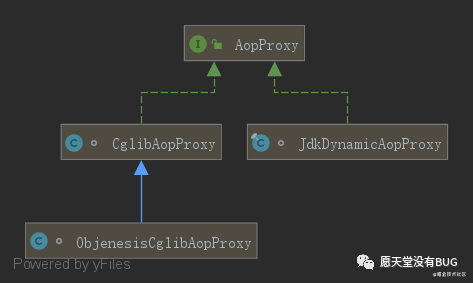一 .前言
上一篇聊过了 AOP 的初始化 , 了解了 AOP 是如何通过 PostProcess 完成 AOP 代理类的创建 ,
二 . AOP 创建起点
AOP 创建的
// 在 AbstractAutoProxyCreator # wrapIfNecessary 中 , 发起了 createProxy 流程用于创建代理类
createProxy(bean.getClass(), beanName, specificInterceptors, new SingletonTargetSource(bean))
下面来看一下该逻辑中主要做了什么 :
复制代码2.1 AbstractAutoProxyCreator 创建 Proxy 代理类
C- AbstractAutoProxyCreator
protected Object createProxy(Class<?> beanClass, @Nullable String beanName,
@Nullable Object[] specificInterceptors, TargetSource targetSource) {
if (this.beanFactory instanceof ConfigurableListableBeanFactory) {
AutoProxyUtils.exposeTargetClass((ConfigurableListableBeanFactory) this.beanFactory, beanName, beanClass);
}
// 构建一个 ProxyFactory
ProxyFactory proxyFactory = new ProxyFactory();
proxyFactory.copyFrom(this);
if (!proxyFactory.isProxyTargetClass()) {
if (shouldProxyTargetClass(beanClass, beanName)) {
proxyFactory.setProxyTargetClass(true);
} else {
evaluateProxyInterfaces(beanClass, proxyFactory);
}
}
// 构建通知者
Advisor[] advisors = buildAdvisors(beanName, specificInterceptors);
proxyFactory.addAdvisors(advisors);
proxyFactory.setTargetSource(targetSource);
customizeProxyFactory(proxyFactory);
proxyFactory.setFrozen(this.freezeProxy);
if (advisorsPreFiltered()) {
proxyFactory.setPreFiltered(true);
}
// 获取代理对象 -> 2.3 Aop 对象创建详情
// org.springframework.aop.framework.ProxyFactory
return proxyFactory.getProxy(getProxyClassLoader());
}
复制代码[PIC] : specificInterceptors 对象内容

[Pro] AutoProxyUtils 的作用
C- AutoProxyUtils : 自动代理的工具类
M- shouldProxyTargetClass : 确定是否应该用目标类而不是接口代理给定bean
M- determineTargetClass : 确定指定bean的原始目标类,否则返回到常规的getType查找
M- exposeTargetClass : 公开指定bean的给定目标类
M- isOriginalInstance : 根据 ORIGINAL_INSTANCE_SUFFIX 确定给定bean名是否指示“原始实例”
static void exposeTargetClass(
ConfigurableListableBeanFactory beanFactory, @Nullable String beanName, Class<?> targetClass) {
if (beanName != null && beanFactory.containsBeanDefinition(beanName)) {
// ORIGINAL_TARGET_CLASS_ATTRIBUTE => org.springframework.aop.framework.autoproxy.AutoProxyUtils.originalTargetClass
beanFactory.getMergedBeanDefinition(beanName).setAttribute(ORIGINAL_TARGET_CLASS_ATTRIBUTE, targetClass);
}
}
// PS : 这里设置了 Attribute 属性 , 后面专门看一下该属性会在什么情况下使用 >>>
复制代码[Pro] ProxyFactory 的作用
用于编程使用的AOP代理的工厂 , 该类提供了在定制用户代码中获取和配置AOP代理实例的简单方法
C- ProxyFactory
MC- ProxyFactory() : 创建一个 ProxyFactory
MC- ProxyFactory(Object target) : 创建时通过 target 设置 Target 和 Interfaces 属性
MC- ProxyFactory(Class<?>... proxyInterfaces) : 没有目标,只有接口且必须添加拦截器
MC- ProxyFactory(Class<?> proxyInterface, Interceptor interceptor) : 用于为单个拦截器创建代理的便利方法
MC- ProxyFactory(Class<?> proxyInterface, TargetSource targetSource) :为指定的TargetSource创建一个ProxyFactory,使代理实现指定的接口
M- getProxy() : 根据这个工厂的设置创建一个新的代理 , 可反复调用
M- getProxy(@Nullable ClassLoader classLoader) :
M- getProxy(Class<T> proxyInterface, Interceptor interceptor)
M- getProxy(Class<T> proxyInterface, TargetSource targetSource)
M- getProxy(TargetSource targetSource)
P- proxyInterface :
P- Interceptor :
P- TargetSource :
复制代码[Pro] Advisor 作用
保存AOP通知(在连接点上要采取的动作)的基本接口和决定通知(如切入点)适用性的过滤器 , Advisor接口允许支持不同类型的通知,比如 Before Advice 和 After Advice
C- Advisor : 通知器
M- getAdvice()
M- isPerInstance()
// 这里说一说 Advisor 是什么时候调用的 >>>
复制代码
2.2 buildAdvisors 创建通知对象
C- AbstractAutoProxyCreator
protected Advisor[] buildAdvisors(@Nullable String beanName, @Nullable Object[] specificInterceptors) {
// 2-2-1 : 将指定的拦截器名称解析为Advisor对象
Advisor[] commonInterceptors = resolveInterceptorNames();
List<Object> allInterceptors = new ArrayList<>();
if (specificInterceptors != null) {
allInterceptors.addAll(Arrays.asList(specificInterceptors));
if (commonInterceptors.length > 0) {
if (this.applyCommonInterceptorsFirst) {
allInterceptors.addAll(0, Arrays.asList(commonInterceptors));
} else {
allInterceptors.addAll(Arrays.asList(commonInterceptors));
}
}
}
Advisor[] advisors = new Advisor[allInterceptors.size()];
for (int i = 0; i < allInterceptors.size(); i++) {
// 2-2-2 : 将指定的拦截器名称解析为Advisor对象
advisors[i] = this.advisorAdapterRegistry.wrap(allInterceptors.get(i));
}
return advisors;
}
// 2-2-1 : 将指定的拦截器名称解析为Advisor对象
private Advisor[] resolveInterceptorNames() {
BeanFactory bf = this.beanFactory;
ConfigurableBeanFactory cbf = (bf instanceof ConfigurableBeanFactory ? (ConfigurableBeanFactory) bf : null);
List<Advisor> advisors = new ArrayList<>();
// 获取通用 interceptor 对象 , 该对象可以 setInterceptorNames 设置
for (String beanName : this.interceptorNames) {
if (cbf == null || !cbf.isCurrentlyInCreation(beanName)) {
Object next = bf.getBean(beanName);
advisors.add(this.advisorAdapterRegistry.wrap(next));
}
}
return advisors.toArray(new Advisor[0]);
}
// 2-2-2 : 将指定的拦截器名称解析为Advisor对象
C- DefaultAdvisorAdapterRegistry
public Advisor wrap(Object adviceObject) throws UnknownAdviceTypeException {
if (adviceObject instanceof Advisor) {
return (Advisor) adviceObject;
}
if (!(adviceObject instanceof Advice)) {
throw new UnknownAdviceTypeException(adviceObject);
}
Advice advice = (Advice) adviceObject;
if (advice instanceof MethodInterceptor) {
// So well-known it doesn't even need an adapter.
return new DefaultPointcutAdvisor(advice);
}
for (AdvisorAdapter adapter : this.adapters) {
// Check that it is supported.
if (adapter.supportsAdvice(advice)) {
return new DefaultPointcutAdvisor(advice);
}
}
throw new UnknownAdviceTypeException(advice);
}
复制代码三 . Aop 代理类的创建流程
上一节通过 CreateProxy 发起了代理的创建 , 此节来说一下 ProxyFactory 的创建流程
Step 1 : 获取代理类主流程 => ProxyFactory
// 类结构 ===================
C- ProxyFactory
E- ProxyCreatorSupport
public Object getProxy(@Nullable ClassLoader classLoader) {
// createAopProxy() => org.springframework.aop.framework.ObjenesisCglibAopProxy
return createAopProxy().getProxy(classLoader);
}
// ProxyCreatorSupport 是 ProxyFactory 的父类 , createAopProxy 会调用该类方法
protected final synchronized AopProxy createAopProxy() {
if (!this.active) {
// 激活代理配置
activate();
}
// getAopProxyFactory() => org.springframework.aop.framework.DefaultAopProxyFactory
return getAopProxyFactory().createAopProxy(this);
}
复制代码Step 2 : AOP 代理工厂的选择
// Aop 基于 Proxy 代理 , 主要接口为 AopProxy , 而 AopProxy 的创建接口类为 AopProxyFactory ,
public interface AopProxyFactory {
/**
* 为给定的AOP配置创建一个AopProxy
*/
AopProxy createAopProxy(AdvisedSupport config) throws AopConfigException;
}
// Aop 代理工厂默认为 DefaultAopProxyFactory
public AopProxy createAopProxy(AdvisedSupport config) throws AopConfigException {
// config.isOptimize() : 返回代理是否应该执行主动优化
// config.isProxyTargetClass() : 返回是否直接代理目标类以及任何接口
// hasNoUserSuppliedProxyInterfaces(config) : 确定所提供的AdvisedSupport是否只指定了SpringProxy接口(或者根本没有指定代理接口)
if (config.isOptimize() || config.isProxyTargetClass() || hasNoUserSuppliedProxyInterfaces(config)) {
Class<?> targetClass = config.getTargetClass();
if (targetClass == null) {
throw new AopConfigException("TargetSource cannot determine target class: " +
"Either an interface or a target is required for proxy creation.");
}
if (targetClass.isInterface() || Proxy.isProxyClass(targetClass)) {
return new JdkDynamicAopProxy(config);
}
return new ObjenesisCglibAopProxy(config);
} else {
return new JdkDynamicAopProxy(config);
}
}
// PS : Spring 类默认会使用 JdkDynamicAopProxy , 自行定制的 AOP 类通常使用 CglibAopProxy
可以通过以下几种方式配置 :
// 方式一 : 构建 Bean 时可以通过配置切换 , 例如 :
@Configuration(proxyBeanMethods = false)
@ConditionalOnClass(ExecutableValidator.class)
@ConditionalOnResource(resources = "classpath:META-INF/services/javax.validation.spi.ValidationProvider")
@Import(PrimaryDefaultValidatorPostProcessor.class)
public class ValidationAutoConfiguration {
@Bean
@ConditionalOnMissingBean
public static MethodValidationPostProcessor methodValidationPostProcessor(Environment environment,
@Lazy Validator validator) {
MethodValidationPostProcessor processor = new MethodValidationPostProcessor();
// 设置代理目标对象
boolean proxyTargetClass = environment.getProperty("spring.aop.proxy-target-class", Boolean.class, true);
processor.setProxyTargetClass(proxyTargetClass);
processor.setValidator(validator);
return processor;
}
}
// 方式二 : 配置 AOP 代理方式
1. 通过 EnableAspectJAutoProxy 配置
2. 通过属性 spring.aop.proxy-target-class 进行配置
复制代码Step 3-1 : CglibAopProxy 创建代理类
C- CglibAopProxy
public Object getProxy(@Nullable ClassLoader classLoader) {
try {
Class<?> rootClass = this.advised.getTargetClass();
Class<?> proxySuperClass = rootClass;
// String CGLIB_CLASS_SEPARATOR = "$$";
// 包含 $$
if (rootClass.getName().contains(ClassUtils.CGLIB_CLASS_SEPARATOR)) {
proxySuperClass = rootClass.getSuperclass();
Class<?>[] additionalInterfaces = rootClass.getInterfaces();
for (Class<?> additionalInterface : additionalInterfaces) {
this.advised.addInterface(additionalInterface);
}
}
// 检查是否已经验证了所提供的Class,如果没有,则验证它
validateClassIfNecessary(proxySuperClass, classLoader);
// 配置 CGLIB 增强 -> RPO31001
Enhancer enhancer = createEnhancer();
if (classLoader != null) {
enhancer.setClassLoader(classLoader);
if (classLoader instanceof SmartClassLoader &&
((SmartClassLoader) classLoader).isClassReloadable(proxySuperClass)) {
enhancer.setUseCache(false);
}
}
enhancer.setSuperclass(proxySuperClass);
enhancer.setInterfaces(AopProxyUtils.completeProxiedInterfaces(this.advised));
enhancer.setNamingPolicy(SpringNamingPolicy.INSTANCE);
enhancer.setStrategy(new ClassLoaderAwareGeneratorStrategy(classLoader));
Callback[] callbacks = getCallbacks(rootClass);
Class<?>[] types = new Class<?>[callbacks.length];
for (int x = 0; x < types.length; x++) {
types[x] = callbacks[x].getClass();
}
// fixedInterceptorMap only populated at this point, after getCallbacks call above
enhancer.setCallbackFilter(new ProxyCallbackFilter(
this.advised.getConfigurationOnlyCopy(), this.fixedInterceptorMap, this.fixedInterceptorOffset));
enhancer.setCallbackTypes(types);
// 生成代理类并创建代理实例
return createProxyClassAndInstance(enhancer, callbacks);
}
catch (CodeGenerationException | IllegalArgumentException ex) {
throw new AopConfigException("Could not generate CGLIB subclass of " + this.advised.getTargetClass() +
": Common causes of this problem include using a final class or a non-visible class",
ex);
}
catch (Throwable ex) {
// TargetSource.getTarget() failed
throw new AopConfigException("Unexpected AOP exception", ex);
}
}
protected Object createProxyClassAndInstance(Enhancer enhancer, Callback[] callbacks) {
enhancer.setInterceptDuringConstruction(false);
enhancer.setCallbacks(callbacks);
// 通过是否存在构造参数分别创建
return (this.constructorArgs != null && this.constructorArgTypes != null ?
enhancer.create(this.constructorArgTypes, this.constructorArgs) :
enhancer.create());
}
// RPO31001 补充 : Enhancer 的作用
通常我们常见的代理方式是通过 Proxy 类 , 而 Enhancer 也是一个方法代理类 , Proxy是基于接口的方式进行代理,Enhancer是基于继承的方式代理
复制代码Step 3-2 : JdkDynamicAopProxy
// JdkDynamicAopProxy 构建代理类
public Object getProxy(@Nullable ClassLoader classLoader) {
Class<?>[] proxiedInterfaces = AopProxyUtils.completeProxiedInterfaces(this.advised, true);
findDefinedEqualsAndHashCodeMethods(proxiedInterfaces);
// 创建代理类
return Proxy.newProxyInstance(classLoader, proxiedInterfaces, this);
}
复制代码AopProxy 代理体系

Spring 中的代理类通常有 2个类 : CglibAopProxy / JdkDynamicAopProxy
// [Pro] : 如何切换 AopProxy 代理类型
复制代码四 . 要点深入
4.1 ORIGINAL_TARGET_CLASS_ATTRIBUTE 属性的使用
// Step 1 : AbstractApplicationContext # refresh
public void refresh() throws BeansException, IllegalStateException {
synchronized (this.startupShutdownMonitor) {
try {
//.................
// 实例化所有剩余的(非lazy-init)单例
finishBeanFactoryInitialization(beanFactory);
// Last step: publish corresponding event.
finishRefresh();
}
//........
}
}
// PS : 可以看到 , 在主流程倒数第二步中 ,
// EventListenerMethodProcessor : 对标注了 @EventListener 的方法进行解析, 然后转换为一个 ApplicationListener
// Step 2: C- EventListenerMethodProcessor # afterSingletonsInstantiated
public void afterSingletonsInstantiated() {
ConfigurableListableBeanFactory beanFactory = this.beanFactory;
String[] beanNames = beanFactory.getBeanNamesForType(Object.class);
for (String beanName : beanNames) {
if (!ScopedProxyUtils.isScopedTarget(beanName)) {
Class<?> type = null;
try {
// 确定指定bean的原始目标类
// Step 2-1 : 获取 originalTargetClass
// beanName -> org.springframework.context.annotation.internalConfigurationAnnotationProcessor
// type -> org.springframework.context.annotation.ConfigurationClassPostProcessor
type = AutoProxyUtils.determineTargetClass(beanFactory, beanName);
}
catch (Throwable ex) {
//...............
}
if (type != null) {
if (ScopedObject.class.isAssignableFrom(type)) {
try {
Class<?> targetClass = AutoProxyUtils.determineTargetClass(
beanFactory, ScopedProxyUtils.getTargetBeanName(beanName));
if (targetClass != null) {
type = targetClass;
}
}
catch (Throwable ex) {
//...............
}
}
try {
// Step 2-3 : 获取 originalTargetClass
processBean(beanName, type);
}
catch (Throwable ex) {
//...............
}
}
}
}
}
// Step 2-1 : 从 BeanDefinition 中获取属性 originalTargetClass
String ORIGINAL_TARGET_CLASS_ATTRIBUTE = Conventions.getQualifiedAttributeName(AutoProxyUtils.class, "originalTargetClass");
BeanDefinition bd = beanFactory.getMergedBeanDefinition(beanName);
Class<?> targetClass = (Class<?>) bd.getAttribute(ORIGINAL_TARGET_CLASS_ATTRIBUTE);
// Step 2-2 : 查找原始目标类 , 可以看到 , 通常查询的类都是 internalXXX 开头的类 , 该类为 beanDefinitionNames 中创建
public static Class<?> determineTargetClass(
ConfigurableListableBeanFactory beanFactory, @Nullable String beanName) {
if (beanName == null) {
return null;
}
if (beanFactory.containsBeanDefinition(beanName)) {
BeanDefinition bd = beanFactory.getMergedBeanDefinition(beanName);
Class<?> targetClass = (Class<?>) bd.getAttribute(ORIGINAL_TARGET_CLASS_ATTRIBUTE);
if (targetClass != null) {
return targetClass;
}
}
return beanFactory.getType(beanName);
}
// Step 2-3 : 该方法省略 , 主要是 EventListener 注解的处理 , 和主流程无关
private void processBean(final String beanName, final Class<?> targetType)
复制代码4.2 AOP Cglib 配置流程
通常基础的AOP 代理是通过
org.springframework.boot.autoconfigure.aop.AopAutoConfiguration$AspectJAutoProxyingConfiguration$CglibAutoProxyConfiguration
public void registerBeanDefinitions(
AnnotationMetadata importingClassMetadata, BeanDefinitionRegistry registry) {
AopConfigUtils.registerAspectJAnnotationAutoProxyCreatorIfNecessary(registry);
// h
AnnotationAttributes enableAspectJAutoProxy =
AnnotationConfigUtils.attributesFor(importingClassMetadata, EnableAspectJAutoProxy.class);
//
if (enableAspectJAutoProxy != null) {
if (enableAspectJAutoProxy.getBoolean("proxyTargetClass")) {
AopConfigUtils.forceAutoProxyCreatorToUseClassProxying(registry);
}
if (enableAspectJAutoProxy.getBoolean("exposeProxy")) {
AopConfigUtils.forceAutoProxyCreatorToExposeProxy(registry);
}
}
}
public static void forceAutoProxyCreatorToUseClassProxying(BeanDefinitionRegistry registry) {
// AUTO_PROXY_CREATOR_BEAN_NAME => org.springframework.aop.config.internalAutoProxyCreator
if (registry.containsBeanDefinition(AUTO_PROXY_CREATOR_BEAN_NAME)) {
BeanDefinition definition = registry.getBeanDefinition(AUTO_PROXY_CREATOR_BEAN_NAME);
definition.getPropertyValues().add("proxyTargetClass", Boolean.TRUE);
}
}
复制代码补充一 : EnableAspectJAutoProxy
public @interface EnableAspectJAutoProxy {
/**
* Indicate whether subclass-based (CGLIB) proxies are to be created as opposed
* to standard Java interface-based proxies. The default is {@code false}.
*/
boolean proxyTargetClass() default false;
/**
* Indicate that the proxy should be exposed by the AOP framework as a {@code ThreadLocal}
* for retrieval via the {@link org.springframework.aop.framework.AopContext} class.
* Off by default, i.e. no guarantees that {@code AopContext} access will work.
* @since 4.3.1
*/
boolean exposeProxy() default false;
}
复制代码补充二 : AopAutoConfiguration 自动配置类
@Configuration(proxyBeanMethods = false)
@ConditionalOnProperty(prefix = "spring.aop", name = "auto", havingValue = "true", matchIfMissing = true)
public class AopAutoConfiguration {
@Configuration(proxyBeanMethods = false)
@ConditionalOnClass(Advice.class)
static class AspectJAutoProxyingConfiguration {
@Configuration(proxyBeanMethods = false)
@EnableAspectJAutoProxy(proxyTargetClass = false)
@ConditionalOnProperty(prefix = "spring.aop", name = "proxy-target-class", havingValue = "false",
matchIfMissing = false)
static class JdkDynamicAutoProxyConfiguration {
}
@Configuration(proxyBeanMethods = false)
@EnableAspectJAutoProxy(proxyTargetClass = true)
@ConditionalOnProperty(prefix = "spring.aop", name = "proxy-target-class", havingValue = "true",
matchIfMissing = true)
static class CglibAutoProxyConfiguration {
}
}
@Configuration(proxyBeanMethods = false)
@ConditionalOnMissingClass("org.aspectj.weaver.Advice")
@ConditionalOnProperty(prefix = "spring.aop", name = "proxy-target-class", havingValue = "true",
matchIfMissing = true)
static class ClassProxyingConfiguration {
ClassProxyingConfiguration(BeanFactory beanFactory) {
if (beanFactory instanceof BeanDefinitionRegistry) {
BeanDefinitionRegistry registry = (BeanDefinitionRegistry) beanFactory;
AopConfigUtils.registerAutoProxyCreatorIfNecessary(registry);
AopConfigUtils.forceAutoProxyCreatorToUseClassProxying(registry);
}
}
}
}
复制代码补充三 : org.springframework.aop.config.internalAutoProxyCreator 的作用
C- AopConfigUtils # String AUTO_PROXY_CREATOR_BEAN_NAME = "org.springframework.aop.config.internalAutoProxyCreator"
?- 内部管理的自动代理创建器的bean名
复制代码总结
讲道理 , 这篇文章其实没写好 , 很多地方现在都没弄清楚 , 精力有限无法在细致深入 , 总得来说算是一个半成品吧 , 后面时间充裕了 , 再来深入看一下
核心概念 :
AbstractAutoProxyCreator # createProxy 发起代理类的创建
AutoProxyUtils 为工具类 , 用于原类和代理的一些常见操作处理
通过 AopProxyFactory 创建代理类 , 有2种 : ObjenesisCglibAopProxy / JdkDynamicAopProxy
作者:AntBlack
链接:https://juejin.cn/post/6980187257856589855
来源:掘金
著作权归作者所有。商业转载请联系作者获得授权,非商业转载请注明出处。





